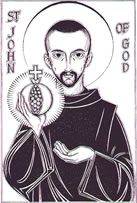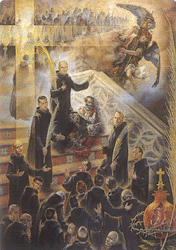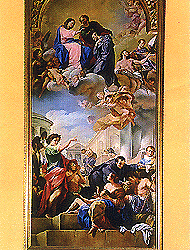SAINTS AND BLESSEDS OF HOSPITALITY
Posted on ottobre 28th, 2009 by Angelo
Posted on Febbraio 24th, 2009 di Angelo |
ST. JOHN OF GOD

 It is now five centuries since the birth of St. John of God. The example of his life is still inspiring people, his work has spread throughout the world. What was it about this man that led so many people to want to help him in his ministry in Granada in the 1540’s? What is it that still inspires the thousands of people who comprise the family of St. John of God today?
It is now five centuries since the birth of St. John of God. The example of his life is still inspiring people, his work has spread throughout the world. What was it about this man that led so many people to want to help him in his ministry in Granada in the 1540’s? What is it that still inspires the thousands of people who comprise the family of St. John of God today?
St. John of God was born John Ciudad in 1495 in a small village in the south of Portugal called Montemor-o-Novo. At the age of eight, in circumstances that are still a mystery, John left home. He was reared by a Spanish family in Oropesa. The greater part of his life was spent as a rootless wanderer, working as a shepherd, soldier, bookseller and labourer and covering in his travel the countries of Europe and North Africa.
When St. John of God finally settled in Granada around the age of forty he underwent a conversion experience so dramatic in its intensity that he was placed in a psychiatric hospital. His brief experience of the kind of treatment meted out to the afflicted gave him an insight into, and understanding of, the real needs of the sick. He decided to devote the rest of his life to caring for those in need.It is now five centuries since the birth of St. John of God. The example of his life is still inspiring people, his work has spread throughout the world. What was it about this man that led so many people to want to help him in his ministry in Granada in the 1540’s? What is it that still inspires the thousands of people who comprise the family of St. John of God today?
ST. RICHARD PAMPURI O.H.

 Richard Pampuri lived nearer to our times. Born at Trivolzio, a small city in the north of Italy in 1897, he graduated from his medical course in 1921, after which he worked as a rural health officer assigned in a poor area near Milan. Even now, the inhabitants of that area still remember him for his charity.
Richard Pampuri lived nearer to our times. Born at Trivolzio, a small city in the north of Italy in 1897, he graduated from his medical course in 1921, after which he worked as a rural health officer assigned in a poor area near Milan. Even now, the inhabitants of that area still remember him for his charity.
Wishing to dedicate himself to the sick in a more complete and total way, he entered the Hospitaller Order of St. John of God in 1927. The Formation house was inside the general hospital managed by the Brothers in Brescia. There he made his religious profession on October 24, 1928.
The Superior entrusted to him the free dental clinic for the poor. Many people flocked to the clinic of Brother Richard not only because of his professional competence but also because of his kindness and gentleness in treating the patients.
Many times he also gave money and food to the needy patients and showed great sensitivity to all. Once there was a malnourished boy who came for dental treatment. After treating him, Brother Richard pretended to ask for money. The astonished boy replied, “But I don’t have money to pay.” Immediately Brother Richard offered money telling him, “Don’t worry, if you can’t pay me, I will pay you.”
Unfortunately, he started to have some health problems in the beginning of 1929. He has tuberculosis, an incurable sickness at that time. His health would only to fall ill again many times, until he has to be confined in the hospital of the Brothers in Milan on April 18, 1930. There he died in the evening on May 1, the date of his liturgical feast since he was proclaimed blessed in 1981. His body was bought to Trivolzio, his birthplace, where it is venerated in the same parish church he was baptized. Pope John Paul II declared him Saint in 1989. The Pope said, “The short but rich life of Richard Pampuri urges the medical doctors, his colleagues, to carry out delicate professional with commitment, to animate it with Christian, human and professional ideals, so that it will become a true mission of social services, of fraternal charity, of true human growth.”
The life of San Richard Pampuri was so short that truly there was no time or opportunity to perform great undertakings. Nonetheless, his life was very meaningful because he held on to a principle which he formulated during his preparation for the Religious Profession, he upheld that: “To do the least of things with great love.” It was precisely his daily adherence to this principle that led him on top of holiness transforming his medical activities into a true mission of charity.
SAINT BENEDICT MENNI

 The typical apostolate of the Brothers of St. John of God is to care for the sick as nurses or doctors. For this reason. from the very beginning, the Hospitaller Order was recognized by the Church as a Congregation of religious brothers with exception of not more than one priest in each community acting as chaplain.
The typical apostolate of the Brothers of St. John of God is to care for the sick as nurses or doctors. For this reason. from the very beginning, the Hospitaller Order was recognized by the Church as a Congregation of religious brothers with exception of not more than one priest in each community acting as chaplain.
Saint Benedict Menni was one exception, being an ordained priest in Rome on October 14, 1860. In those years, the Spanish branch of the Hospitallers Order died away as a consequence of some Masonic laws issued in Portugal in 1834 and in Spain in 1835. Saint Menni was sent to Barcelona on April 6, 1867, to restore the Hospitaller Order in these countries.
After a long struggle, oftentimes risky, he was not only able to gather many vocations – almost a thousand from 1867 to 1903 – but also founded in Spain, Portugal and Mexico, 22 hospitals for every kind of sickness, especially for mental patients and handicapped children. Those conditions were the most neglected by the public health care at that time.
He also founded a female branch of the Order, the Hospitaller Sisters of the Sacred Heart of Jesus. Today, the Sisters are present in 20 Countries with almost 80 communities.
The mother house of the Sisters is in Ciempozuelos, Spain where the body of their founder is venerated. He was declared Blessed in 1985 and his Canonization was celebrated in November 1999. His feast day is April 24, the day he died in Dinan, France in 1914.
What is amazing in the life work of Saint Menni is the number and complexity of the undertakings he faced; but, even more so is their validity, tested for more than a century. The secret lies in his true, heroic detachment by which he always considered himself a docile instrument in the hands of God, without giving room to his personal ambitions or human plans.
MARTYRS OFHOSPITALITY

 While Brother Richard Pampuri attained holiness through the ordinary activities of life, a good number of Brother of St. John of God had to face the ordeals of martyrdom before attaining the glory of Heaven.
While Brother Richard Pampuri attained holiness through the ordinary activities of life, a good number of Brother of St. John of God had to face the ordeals of martyrdom before attaining the glory of Heaven.
In the golden annals of the Order are listed martyrs in Belgium, Poland, Columbia, Chile, Brazil, Philippines and specially in Spain where during the Civil War of 1936, ninety-eight Brothers were killed due to hatred towards their faith.
The process of beatification was successfully terminated for a group of seventy-one Brothers whose martyrdom happened in Spain. Pope John Paul II set October 25, 1992 as the date for their solemn beatification in the Vatican.
Among those seventy-one Blessed, there are seven young natives of Colombia who after their Profession had been sent to Spain to complete their formation. In the history of the church, they are the first from their country to be venerated in church. Consequently, it is worth mentioning their names: Arturo Ayala, Esteban Maya, Eugenio Ramirez, Gaspar Paez, Juan Bautista Velazquez, Melquiades Ramirez, Ruben Lopez. They were shot in Barcelona on August 9, 1936.
Also worth mentioning among those Blessed martyrs is a Spanish one, Brother Guillermo Llop, who lived for ten years in the Roman Province as Master of Novices and later as Prior in Frascati, near Rome.
Brother Guillermo was born in Spain in 1880. At the age of eighteen, he received the habit of the Order. He was with the Roman Province from 1912 to 1922, distinguishing himself specially in the care of the wounded in the First World War. In 1922, he went together with other Brothers to revive the Order in Chile. In 1928, he returned to Spain and at the outbreak of the Civil War, he was made Prior of the Mental Hospital in Ciempozuelos, near Madrid. Although there was an open persecution against the religious and the priests, he decided to stay together with the entire Community to care for the patients, until one day, they were imprisoned. On November 28, 1936, he was shot and his last words were words of forgiveness for his executioners.
Martyrs of Faith
 The 71 champions of charity, animated by a trusly deep motivation, remained loyal to Jesus Christ in their belief in the Christian life and their religious vocation, even to the acceptance of persecution and death, in order to bear witness to their faith and consecration. Their fidelity clashed with marxist communism and the religious oppression of the revolution of the Spanish Militia, which, in an atmosphere of voilent persecution, broke out against the Church and its institutions. In this background was found the fundamental reason for their martyrdom.
The 71 champions of charity, animated by a trusly deep motivation, remained loyal to Jesus Christ in their belief in the Christian life and their religious vocation, even to the acceptance of persecution and death, in order to bear witness to their faith and consecration. Their fidelity clashed with marxist communism and the religious oppression of the revolution of the Spanish Militia, which, in an atmosphere of voilent persecution, broke out against the Church and its institutions. In this background was found the fundamental reason for their martyrdom.
In this background of persecution, the religious, torn from their life of community and of charity, and often after long and cruel periods of imprisonment, were sacrificed and died as martyrs of faith and of Jesus Christ. The greeting “Hasta el Cielo” (See you in Heaven) and the cry “Viva Cristo Rey” (Long live Christ the King) were the last echoes of their faith and brotherhood.
Martyrs of Hospitality
 With the beatification of these 71 hospitaller martyrs the catholic martyrology has been enriched in a significant manner. This is not so much by reason of their number, but more for the precise and special way they died as martyrs of hospitality.
With the beatification of these 71 hospitaller martyrs the catholic martyrology has been enriched in a significant manner. This is not so much by reason of their number, but more for the precise and special way they died as martyrs of hospitality.
To the glorious crown common to all martyrs, is added in the case of our 71 hospitaller martyrs, as a shining ornament, the fact that they gave their lives to witness their vocation and consecration to hospitality in the service of the sick and needy as faithful imitators of Christ, the Good Samaritan, who passed through this world doing good and healing the oppressed.
Therefore, the 71 beatified Hospitaller Brothers, from now on, will be hailed by the Church as Witnesses of mercy and charity even to martyrdom.
The Patronage of the Blessed Virgin Mary

 “In order to meet their debts they sought alms in every quarter. But they were not able to keep up the payment on the building work that had been done and were threatened with eviction unless they could pay twenty thousand francs. They did not know where to turn for the money.
“In order to meet their debts they sought alms in every quarter. But they were not able to keep up the payment on the building work that had been done and were threatened with eviction unless they could pay twenty thousand francs. They did not know where to turn for the money.
One of the Brothers received two hundred francs from his relatives. Instead of putting it towards the debt, Br. John decided to buy a statue of Our Lady with it, consecrate the Province to her maternal protection and trust that she would find a way out of their difficulties. On the 19th November 1826, Brothers and patients knelt before the statue of Our Blessed Lady and she was appointed Superior-General. Her intervention was both rapid and efficacious.
Within a few days two cheques arrived which were quite unexpected, and enough to meet immediate needs. The letter containing one of the cheques was addressed to the Superiors of the Brothers of St. John of God and the postmaster would not hand it over at first believing it was not for them. But the Brothers saw in this a delicate gesture on the part of Our Lady and reward for their trust in her.
Since that time every year on the third Saturday of November, which is now the feast of the Patronage of the Blessed Virgin, the Brothers gather in front of the same statue and place themselves and their patients and hospitals under the protection of the Immaculate Mother of God.”
from The Story of the Hospitallers of St. John of God
Brother Norbert Mc Mahon, O.H.
© 1996 The Brothers of St. John of God
Filed under: THE WORCESTER GUILD OF THE CATHOLIC MEDICAL ASSOCIATION

